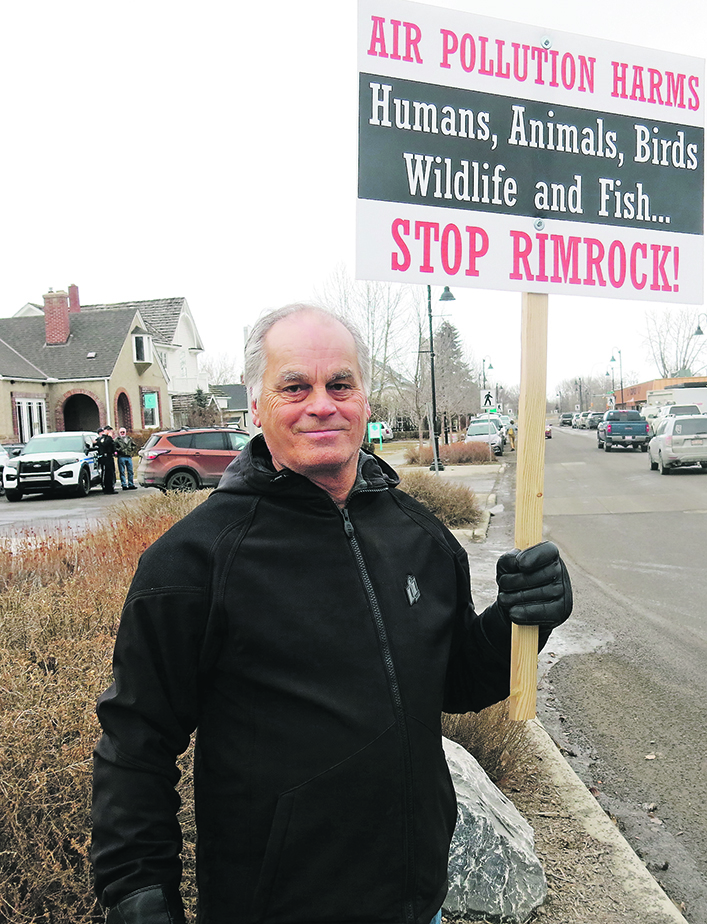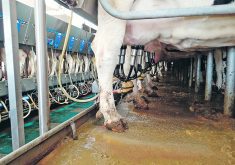People fighting a proposed biodigester facility in Alberta were angered by an estimate that it will reduce the odour from an associated feedlot by 42 percent.
“You can’t sit outside in the summer in High River,” said resident and retired farmer Ann Suitor about the smell from the nearby Rimrock Feeders feedlot, which affected the town of more than 14,000 people last summer.
“You will get sick. You get nauseous. I get migraines from it. People get asthma attacks from it. It is putrid, and this is only going to bring down the odours 42 percent? That is not good enough.”
She was one of about 150 people who attended a public information session Jan. 25 about the biodigester project in person as well as online. Rimrock Renewables Ltd. plans to process manure to create renewable natural gas at a 100-acre site near the feedlot, which is about five kilometres west of High River.
The meeting was held by Foothills County at its council chambers in High River south of Calgary and mostly featured an online presentation by project officials. Protesters held picket signs outside the building before the event.
They included Vern Proctor, who owns an acreage about 2.5 kilometres from the feedlot. If approval is granted by Alberta Environment and Protected Areas, construction on the biodigester facility could begin as early as this spring.
“And for a property that we have invested all our life and all our time into, now it could become worthless?” said Proctor. “It’s not right.”
The provincial Natural Resources Conservation Board (NRCB) received about 250 complaints from High River residents this summer about the feedlot’s odour, which also affected people in Foothills County.
The smell has been calculated at 3.3 million odour units, which is a measurement of the total intensity from several gases, said Cody Halleran, senior air quality and regulatory consultant at Horizon Compliance. The biodigester facility will reduce this odour by an estimated 42 percent, he said.
It will partly use grocery store waste as well as as crop residue, said director of capital projects Denny Boisvert of Rimrock Renewables during an online information session Jan. 12.
However, it will also remove about 80,000 tonnes of manure per year from the feedlot, he said. “This change in manure-handling practice is expected to have a positive effect on odours from the feedlot.”
Halleran said the 3.3 million odour units are associated with the feedlot operating at 35,000 head of cattle.
“The 42-percent reduction in odours associated with (the biodigester) facility, it’s like almost removing almost 15,000 head of cattle from the Rimrock feedlot.”
The facility is also expected to create a non-toxic digestate with a significantly reduced odour, said Boisvert. It will be separated into a liquid that is considered an excellent source of fertilizer, along with a solid that can be used for soils or as bedding material for cattle at the feedlot to offset the use of straw, he said.
However, Suitor feared an increase in smells due to a proposed large pond that will hold the liquid digestate, which will be open to the air.
“In other biodigesters that I read about online, these ponds are covered.”
Rimrock’s pond will provide seven months of operational storage, as well as contain all stormwater generated by the site, said Garnet Dawes, community development manager at ISL Engineering and Land Services Ltd.

Proposed plans involve filling the pond from April to September and would be at maximum depth for only two months of the year, he said.
“Fifty percent of the time, the pond will be one metre in depth or lower, assuming no additional withdrawals from the pond occur during the year.”
Suitor remained unconvinced. She was particularly angered that people attending the meeting Jan. 25 were required to submit questions by Jan. 19, preventing them from voicing their concerns in person.
“We were sitting here hogtied. We were told to sit there and not ask questions and be quiet.”
Jason Schoenfeld of Rimrock Renewables said he understood the importance of being a good neighbour. He grew up in a farm family and now lives about 30 minutes away from the proposed biodigester site.
“Our goal is to employ as many local people as possible at this site. We view this as a win-win situation for everyone involved.
“Rimrock ends up having individuals with local knowledge and relationships within the community, and then the community itself can trust that their neighbours, friends and relatives are also looking out for the best interest of the community while they’re working at this site.”
















